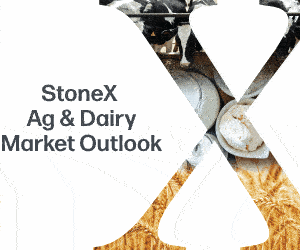 |
|||

|
 |

|
|
Guest Columns
Perspective:
WCMA
Make allowances missed the mark
John Umhoefer
John Umhoefer is executive director of the Wisconsin Cheese Makers Association. He contributes this column monthly for Cheese Market News®.
Has a government program ever been more discussed and less understood than federal milk marketing orders?
As USDA staff push admirably forward through the current reform process for national milk pricing, phone calls from members and dairy farmers are on the rise, betraying a bottomless appetite for understanding how this nearly 100-year-old pricing system works.
Interest grows as USDA is entering the final phase of a nearly two-year process: The agency published its recommended decision on changes for federal orders July 15, 2024, and industry comments are due Sept. 13. USDA will release a final decision in mid-November, and then dairy farmers (or their cooperatives) will vote to accept or reject changes to their order.
The Wisconsin Cheese Makers Association (WCMA) stated in this column last month that industry reaction has been muted to the changes in make allowances in milk price formulas. As Hoard’s Dairyman wrote in the recent August 2024 issue, USDA’s recommended decision “raised make allowances between 5 and 7 cents each for butter, cheese, dry whey and nonfat dry milk. The numbers are above what was proposed by farmers but below what processors advocated for.”
In the recommended decision, USDA did not take the opportunity to focus solely on the best source of data to update make allowances. This best source was the June 2023 cost of production survey created by dairy economist Dr. Mark Stephenson. The International Dairy Foods Association (IDFA) and WCMA commissioned this national survey to provide the best, most up-to-date cost data to USDA. The survey data was presented to USDA, and Dr. Stephenson testified at length during the milk pricing reform public hearing last fall.
In its July recommended decision, USDA brushed aside a second source of data offered by IDFA and WCMA: Dr. Bill Schiek’s statistical model that used 2004 to 2016 California manufacturing cost survey data as a baseline to project future California dairy manufacturing costs.
Instead, USDA leaned on an older 2021 cost of production survey it requested from Dr. Stephenson. To update most of the four make allowances in milk price formulas, USDA decided to average the cost data from this older survey — which features 2019 cost data — with the newer 2023 survey. The result is make allowances watered down with five-year-old data.
Here’s an example: The 2023 survey snagged cost data from 18 Cheddar manufacturers and included 2.2 billion pounds of Cheddar from these makers. The 2023 survey found that the Cheddar make allowance should be 26.43 cents per pound. But USDA added in the 2021 survey data, which had only 10 respondents and represented far less Cheddar — just 610 million pounds. Averaging in that older data caused USDA to announce a lower proposed Cheddar make allowance: 25.04 cents.
That pattern continued for the other dairy commodities that have a make allowance in milk price formulas:
• The butter cost of production in the 2023 survey was pegged at 31.76 cents per pound. USDA again added in the older 2021 survey data and announced a 22.57 cent make allowance for butter.
• The nonfat dry milk cost of production in the 2023 survey was 27.5 cents per pound. Instead, USDA selected much older data — a simple average of the 2021 survey average value and the 2016 California manufacturing cost survey — to announce a 22.68 cent make allowance.
• The dry whey cost of production in the 2023 survey was 33.61 cents per pound. Here, USDA used the old 2021 survey and added not the average cost in the 2023 survey, but the “low cost” portion of the 2023 survey data. This sleight of hand allowed USDA to lower the make allowance to 26.53 cents.
Dairy farmer and processor calls coming into WCMA are focused on the producer vote in Upper Midwest Order 30. Will farmers and their cooperatives accept USDA’s complex array of proposed changes for milk pricing, such as the new make allowances described above?
In recent days, at the request of WCMA, the Dairy Markets and Policy team at the University of Wisconsin — Dr. Stephenson and Dr. Charles Nicholson — analyzed the milk price impact of all the milk price reforms on the Upper Midwest order. Stephenson and Nicholson estimated farm milk values, including over-order premiums, making their estimates similar to an “all milk” price.
Here’s the bottom line: Pooled milk in the Upper Midwest will have slightly lower prices if USDA’s proposed milk pricing reforms are implemented (compared to today’s formulas). Their estimate of these lower prices for pooled milk would include:
• $0.01 lower in 2024;
• $0.15 lower in 2025;
• $0.09 lower in 2026;
• $0.16 lower in 2027; and
• $0.22 lower in 2028.
These economists added an estimate that with no federal order in the Upper Midwest, the milk price values stated above would be $0.05 lower each year — it’s their estimate that the order’s shared pool is providing about a nickel of benefit per hundredweight of milk.
Reforming milk prices using the aged federal order system is a challenging task, and difficult for the dairy industry to digest. Here, and in upcoming articles, webinars and newsletter pieces, our association will share details of the reforms proposed by USDA.
CMN
The views expressed by CMN’s guest columnists are their own opinions and do not necessarily reflect those of Cheese Market News®.
| CMN article search |

|
© 2025 Cheese Market News • Quarne Publishing, LLC • Legal Information • Online Privacy Policy • Terms and Conditions
Cheese Market News • Business/Advertising Office: P.O. Box 628254 • Middleton, WI 53562 • 608/831-6002
Cheese Market News • Editorial Office: 5315 Wall Street, Suite 100 • Madison, WI 53718 • 608/288-9090